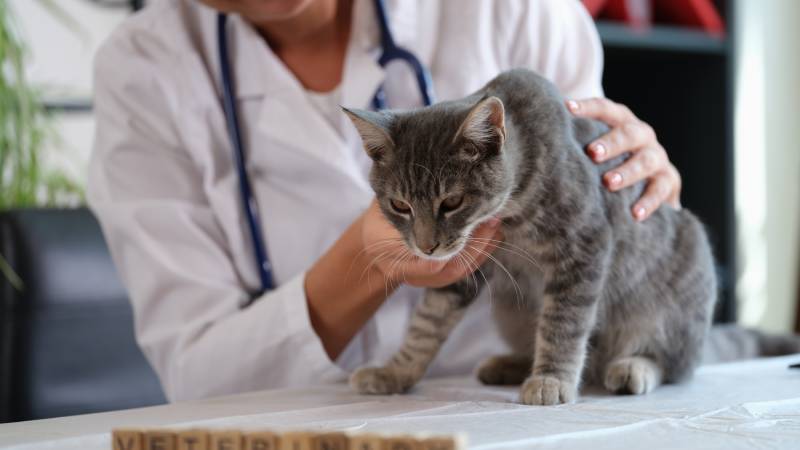
Click Below to Skip Ahead
Just like people, cats can develop diabetes mellitus. A complication of this disease is diabetic neuropathy. While people may experience “pins and needles” in their legs and feet, cats may show signs of weakness, incoordination of their legs, and muscle wasting. For cats diagnosed with diabetes, treating the condition with insulin therapy can improve the signs of diabetic neuropathy.
What Is Diabetic Neuropathy?
Diabetic neuropathy can occasionally occur in cats as a complication of diabetes mellitus. This uncommon issue is caused by prolonged elevated blood sugar levels (hyperglycemia), which damages tissues and nerve cells, most commonly the femoral nerve. Approximately 10% of cats may be affected by diabetic neuropathy.1

What Are the Signs of Diabetic Neuropathy in Cats?
Cats suffering from diabetic neuropathy may show signs of nervous system dysfunction, such as weakness, limb ataxia (incoordination), muscle atrophy (wasting), and a plantigrade stance.
A plantigrade stance is where the cat stands on their hocks or ankles instead of distributing their body weight on their hind paws when standing normally. This can also be described as a “flat-footed” stance and is common in cats with diabetic neuropathy. While this stance in bears, rabbits, and people is normal, it is abnormal in cats. As the disease progresses and goes untreated, it can lead to further joint and nerve damage, resulting in pain and the inability to walk.
What Are the Causes of Diabetic Neuropathy in Cats?
Diabetes mellitus is a common endocrine disorder in cats, occurring in approximately one out of every 230 cats.2 It causes an increase in blood sugar levels by either a decreased production and secretion of insulin or a resistance to it.
Insulin is a hormone secreted into the bloodstream from islet cells in the pancreas. It helps control the amount of sugar, or glucose, in the blood. Islet cells can be damaged or destroyed by a buildup of a pathological protein called amyloid. In some cases, a cat’s immune system may attack and destroy islet cells, leading to a decreased production of insulin. Overweight cats may be prone to insulin resistance, as obesity increases this risk.
Although diabetes can occur in all cat breeds, ages, and sexes, some cats may be more predisposed than others. Risk factors include middle-aged to older cats, obesity, and breed. Breeds of cats that are more commonly affected include Abyssinian, Burmese, Norwegian Forest Cat, Russian Blue, and Tonkinese. Weight also plays a role, and obese male cats are more susceptible to developing diabetes than females.
Diabetes is a chronic medical condition, and signs may develop slowly over weeks or months.
The signs of diabetes can be worsened by stress, obesity, and steroid hormones like corticosteroids. Diabetic neuropathy may initially present as weakness in the hindlimbs, which are usually more affected than the front limbs. Chronic or recurrent infections are often sequelae of diabetes in cats. Diabetic cats may also have an enlarged liver and fatty liver disease (hepatic lipidosis).
Diabetes mellitus is diagnosed through blood and urine tests, which will show higher-than-normal levels of sugar even after a period of fasting. However, cats under stress, such as those visiting a veterinary clinic, can have increased glucose in their blood samples. This is known as stress-induced hyperglycemia and is a temporary condition. Therefore, several evaluations and testing may be necessary to definitively diagnose diabetes in cats.
How Do I Care for a Cat With Diabetic Neuropathy?

First, diabetes must be controlled. This is typically accomplished through dietary changes, weight loss, and insulin injections. You’ll be working closely with your veterinarian, who will determine the optimal plan for weight loss and the dosage and timing of insulin injections.
Second, you’ll need to monitor your cat’s blood glucose levels. Your vet may delegate this task to you to do at home to get more accurate results, especially if your cat is easily stressed. At-home pet glucose monitoring kits can be purchased to easily track your cat’s diabetes. Your veterinarian will make any necessary adjustments to their medication regimen based on the test results. Otherwise, your cat should be tested in the clinic every few months to verify that the disease is being controlled appropriately. The normal glucose level in cats is 80 to 120 mg/dl (up to 300 mg/dl may be normal in cats).
All instructions from your veterinarian regarding your cat’s diabetes management need to be followed closely. Always consult with your veterinarian before changing any aspect of your cat’s care, especially with the dosage and timing of insulin administration. There is a fine line between too much and too little insulin. Overdosing insulin can result in hypoglycemia (low blood sugar), which is considered a medical emergency. Underdosing can cause diabetic ketoacidosis, which also requires immediate treatment.
| Condition | Signs |
| Hypoglycemia |
|
| Diabetic ketoacidosis |
|
The progression of diabetic neuropathy may take several months, but the condition can improve within 6–12 months if properly treated and managed with insulin therapy. Some cats do well with weight loss and dietary changes only, not needing insulin at all. Other diabetic cats may even achieve remission of the disease. Vitamin B12 may aid in the healing process, as it can encourage nerve growth. However, if the neuropathy is advanced, there may only be slight improvements with treatment. The key is monitoring blood glucose levels to ensure that they are within the normal range for cats.
Frequently Asked Questions
Can a Cat Recover From Diabetic Neuropathy?
If the disease is caught early and diabetes is controlled, cats can recover from the condition within 6 to 12 months.
Is Diabetic Neuropathy Painful in Cats?
The condition can be painful, especially if nerves and joints are chronically affected by the cat’s plantigrade stance.
What Should I Avoid Feeding My Diabetic Cat?
Avoid carbohydrates and sugars, as these can contribute to blood sugar spikes.

Conclusion
Diabetic neuropathy is an uncommon condition arising from uncontrolled diabetes mellitus. Prolonged levels of high blood sugar can damage nerve tissue, particularly in a cat’s hind legs. This may present as weakness, ataxia, muscle atrophy, and a plantigrade stance. The condition can be reversed if signs are caught early and the diabetes is controlled.
Featured Image Credit: Pressmaster, Shutterstock








